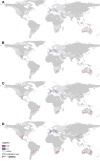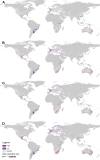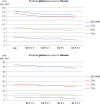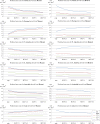Impacts of Climate Change on the Global Invasion Potential of the African Clawed Frog Xenopus laevis
- PMID: 27248830
- PMCID: PMC4889038
- DOI: 10.1371/journal.pone.0154869
Impacts of Climate Change on the Global Invasion Potential of the African Clawed Frog Xenopus laevis
Abstract
By altering or eliminating delicate ecological relationships, non-indigenous species are considered a major threat to biodiversity, as well as a driver of environmental change. Global climate change affects ecosystems and ecological communities, leading to changes in the phenology, geographic ranges, or population abundance of several species. Thus, predicting the impacts of global climate change on the current and future distribution of invasive species is an important subject in macroecological studies. The African clawed frog (Xenopus laevis), native to South Africa, possesses a strong invasion potential and populations have become established in numerous countries across four continents. The global invasion potential of X. laevis was assessed using correlative species distribution models (SDMs). SDMs were computed based on a comprehensive set of occurrence records covering South Africa, North America, South America and Europe and a set of nine environmental predictors. Models were built using both a maximum entropy model and an ensemble approach integrating eight algorithms. The future occurrence probabilities for X. laevis were subsequently computed using bioclimatic variables for 2070 following four different IPCC scenarios. Despite minor differences between the statistical approaches, both SDMs predict the future potential distribution of X. laevis, on a global scale, to decrease across all climate change scenarios. On a continental scale, both SDMs predict decreasing potential distributions in the species' native range in South Africa, as well as in the invaded areas in North and South America, and in Australia where the species has not been introduced. In contrast, both SDMs predict the potential range size to expand in Europe. Our results suggest that all probability classes will be equally affected by climate change. New regional conditions may promote new invasions or the spread of established invasive populations, especially in France and Great Britain.
Conflict of interest statement
Figures





Similar articles
-
Global realized niche divergence in the African clawed frog Xenopus laevis.Ecol Evol. 2017 May 10;7(11):4044-4058. doi: 10.1002/ece3.3010. eCollection 2017 Jun. Ecol Evol. 2017. PMID: 28616199 Free PMC article.
-
Ecophysiological models for global invaders: Is Europe a big playground for the African clawed frog?J Exp Zool A Ecol Integr Physiol. 2021 Jan;335(1):158-172. doi: 10.1002/jez.2432. Epub 2020 Dec 2. J Exp Zool A Ecol Integr Physiol. 2021. PMID: 33264517
-
How climate change might influence the potential distribution of weed, bushmint (Hyptis suaveolens)?Environ Monit Assess. 2015 Apr;187(4):210. doi: 10.1007/s10661-015-4415-8. Epub 2015 Mar 26. Environ Monit Assess. 2015. PMID: 25810084
-
Climate change and biological invasions: evidence, expectations, and response options.Biol Rev Camb Philos Soc. 2017 Aug;92(3):1297-1313. doi: 10.1111/brv.12282. Epub 2016 May 31. Biol Rev Camb Philos Soc. 2017. PMID: 27241717 Review.
-
What do we really know about alien plant invasion? A review of the invasion mechanism of one of the world's worst weeds.Planta. 2016 Jul;244(1):39-57. doi: 10.1007/s00425-016-2510-x. Epub 2016 Apr 7. Planta. 2016. PMID: 27056056 Review.
Cited by
-
Are invasive populations characterized by a broader diet than native populations?PeerJ. 2017 May 16;5:e3250. doi: 10.7717/peerj.3250. eCollection 2017. PeerJ. 2017. PMID: 28533950 Free PMC article.
-
Global realized niche divergence in the African clawed frog Xenopus laevis.Ecol Evol. 2017 May 10;7(11):4044-4058. doi: 10.1002/ece3.3010. eCollection 2017 Jun. Ecol Evol. 2017. PMID: 28616199 Free PMC article.
-
Current and future climatic regions favourable for a globally introduced wild carnivore, the raccoon Procyon lotor.Sci Rep. 2019 Jun 24;9(1):9174. doi: 10.1038/s41598-019-45713-y. Sci Rep. 2019. PMID: 31235806 Free PMC article.
-
A spectacular new species of Hyloscirtus (Anura: Hylidae) from the Cordillera de Los Llanganates in the eastern Andes of Ecuador.PeerJ. 2022 Sep 29;10:e14066. doi: 10.7717/peerj.14066. eCollection 2022. PeerJ. 2022. PMID: 36196397 Free PMC article.
-
Overland movement in African clawed frogs (Xenopus laevis): a systematic review.PeerJ. 2016 Sep 20;4:e2474. doi: 10.7717/peerj.2474. eCollection 2016. PeerJ. 2016. PMID: 27688972 Free PMC article.
References
-
- Hoegh-Guldberg O. Climate change, coral bleaching and the future of the world’s coral reefs. Mar Freshw Res. 1999;50: 839–866.
-
- Smith RC, Ainley D, Baker K, Domack E, Emslie S, et al. Marine Ecosystem Sensitivity to Climate Change Historical observations and paleoecological records reveal ecological transitions in the Antarctic Peninsula region. BioScience. 1999;49: 393–404.
-
- Parmesan C, Root TL, Willig M. Impacts of extreme weather and climate on terrestrial biota. Bull Am Meteorol Soc. 2000;81: 443–450.
-
- Peñuelas J, Flella I. Responses to a warming world. Science. 2001;294: 793–795. - PubMed
-
- Pounds JA. Climate and amphibian declines. Nature. 2001;410: 639–664. - PubMed
MeSH terms
LinkOut - more resources
Full Text Sources
Other Literature Sources
Medical

